Statler Fountain
1930 establishments in Massachusetts1930 sculpturesArt Deco architecture in MassachusettsArt Deco sculptures and memorialsBronze sculptures in Massachusetts ... and 7 more
Concrete sculptures in MassachusettsFountains in MassachusettsGranite sculptures in MassachusettsMassachusetts sculpture stubsOutdoor sculptures in BostonSculptures of women in MassachusettsStatues in Boston

Statler Fountain is a 1930 fountain designed by Ulysses Anthony Ricci, installed in Boston's Statler Park, in the U.S. state of Massachusetts. The Art Deco fountain features a bronze statue of a woman. It was surveyed as part of the Smithsonian Institution's "Save Outdoor Sculpture!" program in 1993.
Excerpt from the Wikipedia article Statler Fountain (License: CC BY-SA 3.0, Authors, Images).Statler Fountain
Stuart Street, Boston Back Bay
Geographical coordinates (GPS) Address Website External links Nearby Places Show on map
Geographical coordinates (GPS)
| Latitude | Longitude |
|---|---|
| N 42.350638888889 ° | E -71.068944444444 ° |
Address
Statler Fountain
Stuart Street
02117 Boston, Back Bay
Massachusetts, United States
Open on Google Maps







